Learning multi-level topology representation for multi-view clustering with deep non-negative matrix factorization
IF 6
1区 计算机科学
Q1 COMPUTER SCIENCE, ARTIFICIAL INTELLIGENCE
引用次数: 0
Abstract
Clustering of multi-view data divides objects into groups by preserving structure of clusters in all views, requiring simultaneously takes into consideration diversity and consistency of various views, corresponding to the shared and specific components of various views. Current algorithms fail to fully characterize and balance diversity and consistency of various views, resulting in the undesirable performance. Here, a novel Multi-View Clustering with Deep non-negative matrix factorization and Multi-Level Representation (MVC-DMLR) learning is proposed, which integrates feature learning, multi-level topology representation, and clustering of multi-view data. Specifically, MVC-DMLR first learns multi-level representation (also called deep features) of objects with deep nonnegative matrix factorization (DNMF), facilitating the exploitation of hierarchical structure of multi-view data. Then, it learns multi-level graphs for each view from multi-level representation, where relations between diversity and consistency are addressed at various resolutions. MVC-DMLR integrates multi-level representation learning, multi-level topology representation learning and clustering, which is formulated as an optimization problem. Experimental results show the superiority of MVC-DMLR to baselines in terms of accuracy, F1-score, normalized mutual information and adjusted rand index.
利用深度非负矩阵因式分解学习多视图聚类的多级拓扑表示。
多视图数据的聚类是通过保留所有视图中的聚类结构将对象划分为若干组,要求同时考虑各种视图的多样性和一致性,与各种视图的共享和特定组件相对应。目前的算法无法充分表征和平衡各种视图的多样性和一致性,导致性能不理想。在此,我们提出了一种新颖的多视图聚类与深度非负矩阵因式分解和多级表示(MVC-DMLR)学习方法,它将特征学习、多级拓扑表示和多视图数据聚类整合在一起。具体来说,MVC-DMLR 首先利用深度非负矩阵因式分解(DNMF)学习对象的多层次表示(也称为深度特征),从而便于利用多视图数据的层次结构。然后,它根据多级表示为每个视图学习多级图,在不同分辨率下处理多样性和一致性之间的关系。MVC-DMLR 集成了多级表示学习、多级拓扑表示学习和聚类,并将其表述为一个优化问题。实验结果表明,MVC-DMLR 在准确率、F1-分数、归一化互信息和调整后的兰德指数方面都优于基线。
本文章由计算机程序翻译,如有差异,请以英文原文为准。
求助全文
约1分钟内获得全文
求助全文
来源期刊

Neural Networks
工程技术-计算机:人工智能
CiteScore
13.90
自引率
7.70%
发文量
425
审稿时长
67 days
期刊介绍:
Neural Networks is a platform that aims to foster an international community of scholars and practitioners interested in neural networks, deep learning, and other approaches to artificial intelligence and machine learning. Our journal invites submissions covering various aspects of neural networks research, from computational neuroscience and cognitive modeling to mathematical analyses and engineering applications. By providing a forum for interdisciplinary discussions between biology and technology, we aim to encourage the development of biologically-inspired artificial intelligence.
 求助内容:
求助内容: 应助结果提醒方式:
应助结果提醒方式:


